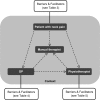Why Neck Pain Patients Are Not Referred to Manual Therapy: A Qualitative Study among Dutch Primary Care Stakeholders
- PMID: 27311067
- PMCID: PMC4911043
- DOI: 10.1371/journal.pone.0157465
Why Neck Pain Patients Are Not Referred to Manual Therapy: A Qualitative Study among Dutch Primary Care Stakeholders
Abstract
Background: Treatment of neck pain with manual therapy demonstrated to be more effective and cost-effective than general practitioner (GP) care or physiotherapy in a high quality RCT in the Netherlands in 2002. However, referral to manual therapy for neck pain is still relatively low. This study aims to explore the barriers and facilitators affecting the implementation of manual therapy in neck pain management in primary care.
Methods: An explorative study was conducted comprising semi-structured interviews with GPs (n = 13), physiotherapists (n = 10), manual therapists (n = 7) and their patients with neck pain (n = 27), and three focus groups with additional stakeholders (n = 10-12 per group). A thematic analysis approach was used.
Results: Different barriers and facilitators for referral were found for patients, GPs and physiotherapists on the individual level, but also in the interaction between stakeholders and their context. Individual perceptions such as knowledge and beliefs about manual therapy for neck pain either impeded or facilitated referral. Fear for complications associated with cervical manipulation was an important barrier for patients as well as GPs. For GPs and physiotherapists it was important whether they perceived it was part of their professional role to refer for manual therapy. Existing relations formed referral behavior, and the trust in a particular practitioner was a recurrent theme among GPs and physiotherapist as well as patients. The contextual factor availability of manual therapy played a role for all stakeholders.
Conclusions: Barriers and facilitators were found especially in individual perceptions on manual therapy for neck pain (e.g. knowledge and beliefs), the interaction between stakeholders (e.g. collaboration and trust) and the organizational context. Implementation strategies that focus on these different aspects seem to be likely to optimize referral rates and the use of manual therapy in primary care management of neck pain.
Conflict of interest statement
Figures

References
-
- Vos T, Flaxman AD, Naghavi M, Lozano R, Michaud C, Ezatti M, et al. (2012) Years lived with disability (YLDs) for 1160 sequelae of 289 diseases and injuries 1990–2010: a systematic analysis for the Global Burden of Disease Study 2010. Lancet 380: 2163–2196. 10.1016/S0140-6736(12)61729-2 - DOI - PMC - PubMed
-
- Borghouts JA, Koes BW, Vondeling H, Bouter LM (1999) Cost-of-illness of neck pain in The Netherlands in 1996. Pain 80: 629–636. - PubMed
-
- Bogduk N (1999) Regional musculoskeletal pain. The neck. Baillieres Best Pract Res Clin Rheumatol 13: 261–285. - PubMed
MeSH terms
LinkOut - more resources
Full Text Sources
Other Literature Sources
Medical

